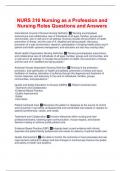NURS 316 Nursing as a Profession and
Nursing Roles Questions and Answers
International Council of Nurses Nursing Definition ✅"Nursing encompasses
autonomous and collaborative care of individuals of all ages, families, groups and
communities, sick or well and in all settings. Nursing includes the promotion of health,
prevention of illness, and the care of ill, disabled and dying people. Advocacy,
promotion of a safe environment, research, participation in shaping health policy and in
patient and health systems management, and education are also key nursing roles."
World Health Organization Nursing Definition ✅"Nursing encompasses autonomous
and collaborative care of individuals of all ages, families, groups and communities, sick
or well and in all settings. It includes the promotion of health, the prevention of illness,
and the care of ill, disabled and dying people."
American Nurses Association Nursing Definition ✅"Nursing is the protection,
promotion, and optimization of health and abilities, prevention of illness and injury,
facilitation of healing, alleviation of suffering through the diagnosis and treatment of
human response, and advocacy in the care of individuals, families, groups,
communities, and populations."
Quality and Safety Education for Nurses (QSEN) ✅-Patient-Centered Care
-Teamwork and Collaboration
-Evidence-Based Practice
-Quality Improvement
-Safety
-Informatics
Patient-Centered Care ✅Recognize the patient or designee as the source of control
and full partner in providing compassionate and coordinated care based on respect for
patient's preferences, values, and needs.
Teamwork and Collaboration ✅Function effectively within nursing and inter-
professional teams, fostering open communication, mutual respect, and shared
decision-making to achieve quality patient care.
Evidence Based Practice (EBP) ✅Integrate best current evidence with clinical
expertise and patient/family preferences and values for delivery of optimal health care.
Quality Improvement ✅Use data to monitor the outcomes of care processes and use
improvement methods to design and test changes to continuously improve the quality
and safety of health care systems.
, Safety ✅Minimizes risk of harm to patients and providers through both system
effectiveness and individual performance.
Informatics ✅Use information and technology to communicate, manage knowledge,
mitigate error, and support decision making.
Licensed Practical Nurses (LPN) or Licensed Vocational Nurses (LVN) ✅-support the
core health care team and work under supervisions of an RN, APRN, or MD
Key responsibilities of LPN's/LVN's ✅-Check vital signs and look for sign that health is
deteriorating or improving
-perform basic nursing functions
-ensure patients are comfortable, well-fed, hydrated
-may administer meds in some settings
Registered Nurses (RN) ✅form the backbone of health care provisions in the US.
Provide critical care to the public whenever needed.
Key responsibilities of RN's ✅-perform physical exams
-provide health promotion, counseling, and education
-admin. meds and other personalized interventions
-coordinate care, in collaboration with a wide array of health care professionals
Advanced Practice Registered Nurse (APRN) ✅Hold at least a Master's Degree, in
addition to initial nursing education and licensing required for RN's
Responsibilities of APRNs ✅-provide invaluable primary and preventative health care
to the public
-treat and diagnose illnesses
-advise the public on heath issues
-manage chronic diseases and engage in continuous education
APRN's Practice Specialist Roles ✅-Nurse Practitioners
-Certified Nurse-Midwives
-Clinical Nurse Specialists
-Certified Registered Nurse Anesthetists
Nurse Practioners (NP) ✅-prescribe medication
-diagnose and treat minor illnesses and injuries
Certified Nurse-Midwives ✅provide gynecological and low-risk OB care
Clinical Nurse Specialist (CNS) ✅handle physical and mental health problems




